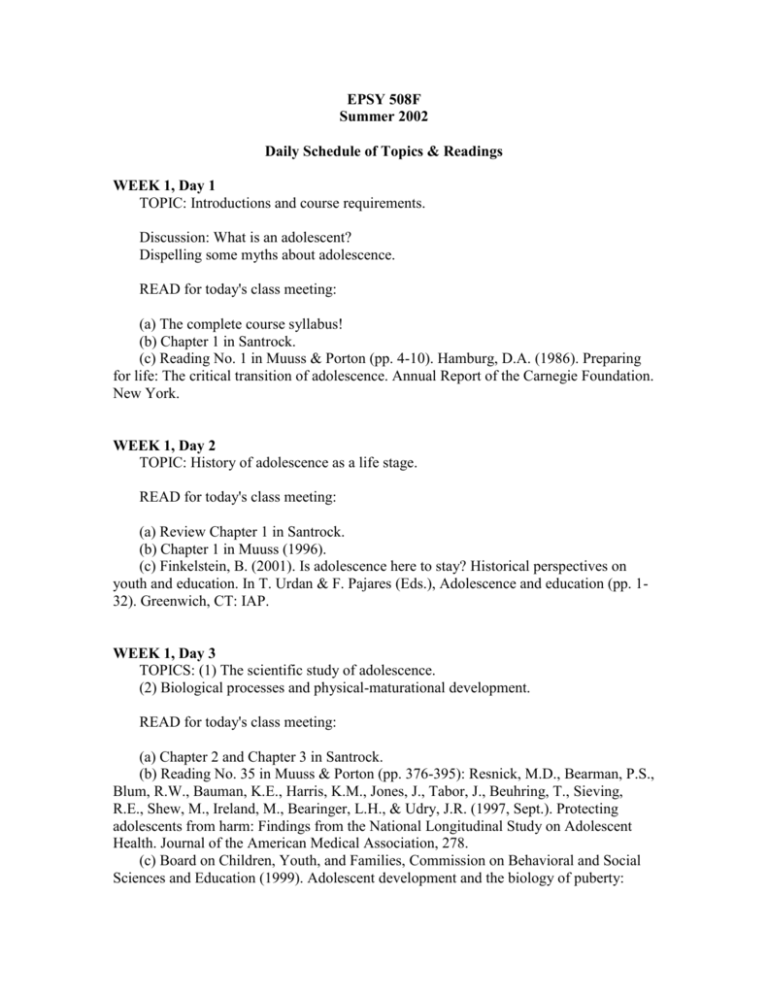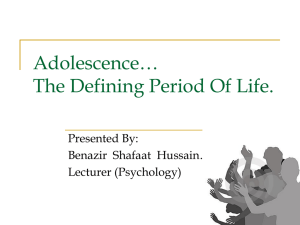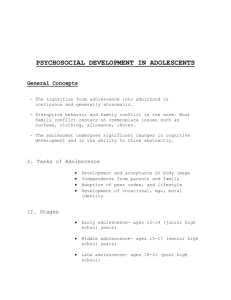EPSY 508F - NIU College of Education
advertisement

EPSY 508F Summer 2002 Daily Schedule of Topics & Readings WEEK 1, Day 1 TOPIC: Introductions and course requirements. Discussion: What is an adolescent? Dispelling some myths about adolescence. READ for today's class meeting: (a) The complete course syllabus! (b) Chapter 1 in Santrock. (c) Reading No. 1 in Muuss & Porton (pp. 4-10). Hamburg, D.A. (1986). Preparing for life: The critical transition of adolescence. Annual Report of the Carnegie Foundation. New York. WEEK 1, Day 2 TOPIC: History of adolescence as a life stage. READ for today's class meeting: (a) Review Chapter 1 in Santrock. (b) Chapter 1 in Muuss (1996). (c) Finkelstein, B. (2001). Is adolescence here to stay? Historical perspectives on youth and education. In T. Urdan & F. Pajares (Eds.), Adolescence and education (pp. 132). Greenwich, CT: IAP. WEEK 1, Day 3 TOPICS: (1) The scientific study of adolescence. (2) Biological processes and physical-maturational development. READ for today's class meeting: (a) Chapter 2 and Chapter 3 in Santrock. (b) Reading No. 35 in Muuss & Porton (pp. 376-395): Resnick, M.D., Bearman, P.S., Blum, R.W., Bauman, K.E., Harris, K.M., Jones, J., Tabor, J., Beuhring, T., Sieving, R.E., Shew, M., Ireland, M., Bearinger, L.H., & Udry, J.R. (1997, Sept.). Protecting adolescents from harm: Findings from the National Longitudinal Study on Adolescent Health. Journal of the American Medical Association, 278. (c) Board on Children, Youth, and Families, Commission on Behavioral and Social Sciences and Education (1999). Adolescent development and the biology of puberty: Summary of a workshop on new research. National Research Council Institute of Medicine. [On-line at: http://www.nap.edu/html/ado_dev_bio_pub/] WEEK 1, Day 4 TOPIC: Cognitive and social-cognitive development I: Piaget's theory. READ for today's class meeting: (a) Chapter 4 in Santrock. (b) Clarke, M., Abrams, L., & Madaus, G. (2001). The effects and implications of high stakes achievement tests for adolescents. In T. Urdan & F. Pajares (Eds.), Adolescence and education (pp. 201-230). Greenwich, CT: IAP. (c) Chapter 8 and Chapter 11 in Muuss (1996). Recommended: (d) Reading No. 10 in Muuss & Porton (pp. 91-97). Elkind, D. (1967). Egocentrism in adolescence. Child Development, 38. WEEK 2, Day 5 TOPIC: Social-cognitive development II: The self and identity development. Favorite Hat Day (wear your favorite hat to class!) READ for today's class meeting: (a) Chapter 9 in Santrock. (b) Reading No. 23 in Muuss & Porton (pp 252-260): Erikson, E.H. (1960, Mar.Apr.). Youth and the life cycle. Children, 7. (c) Woolfolk Hoy, A., Demerath, P., & Pape, S. (2001). Teaching adolescents: Engaging developing selves. In T. Urdan & F. Pajares (Eds.), Adolescence and education (pp. 119-161). (d) Chapter 3 and Chapter 4 in Muuss (1996). Recommended: (e) Reading No. 24 in Muuss & Porton (pp. 261-270). Muuss, R.E. (1996). Marcia's expansion of Erikson's theory of identity formation. Theories of adolescence (6th ed.). McGraw-Hill. WEEK 2, Day 6 TOPIC: Social-cognitive development III: Moral development and moral education. READ for today's class meeting: (a) Chapter 12 in Santrock. (b) Reading No. 20 in Muuss & Porton (pp. 222-233). Kohlberg, L. (1975). The cognitive-developmental approach to moral education. Phi Delta Kappan, 56. (c) Reading No. 22 in Muuss & Porton (pp. 241-248). Gilligan, C., & Attanucci, J. (1988). Two moral orientations. In C. Gilligan, J.V. Ward, & J. McLean Taylor (Eds.), Mapping the moral domain. Harvard University Press. (d) Chapter 9 in Muuss (1996). WEEK 2, Day 7 TOPIC: Contexts for development I: Families. READ for today's class meeting: (a) Chapter 5 in Santrock. (b) Reading No. 11 in Muuss & Porton (pp. 102-117). Montemayor, R. (1983). Parents and adolescents in conflict. Journal of Early Adolescence, 3. (c) Reading No. 13 in Muuss & Porton (pp. 136-140). Field, T., Lang, C., Yando, R., & Bendell, D. (1995). Adolescents' intimacy with parents and friends. Adolescence, 30, 117, 133-140. Recommended: (c) Larson, R., & Richards, M.H. (1994). Healthy families: Toward convergent realities: In Divergent Realities: The emotional lives of mothers, fathers, and adolescents (pp. 211-227).New York: Basic Books. [On-line; see External Links.] WEEK 2, Day 8 TOPIC: Contexts for development II: The peer group. READ for today's class meeting: (a) Chapter 6 in Santrock (b) Reading No. 15 in Muuss & Porton (pp. 158-169). Stone, M.R., & Brown, B.B. (1998). In the eye of the beholder: Adolescents' perceptions of peer crowd stereotypes. In R. Muuss & H.D. Porton (Eds.), Adolescent behavior and society (5th ed.). Boston: McGraw-Hill. (c) Wentzel, K.R., & Battle, A.A. (2001). Social relationships and school adjustment. In T. Urdan & F. Pajares (Eds.), Adolescence and education (pp. 93-118). Greenwich, CT: IAP. (d) Chapter 14 in Muuss (1996). Recommended: (e) Reading No. 14 in Muuss & Porton (pp. 144-158). Hartup, W. (1996). The company they keep: Friendships and their developmental significance. Child Development, 67. (f) Reading No. 16 in Muuss & Porton (pp. 170-174). Berndt, T.J. (1992). Friendship and friends' influence in adolescence. Current Directions in Psychological Science, 1. WEEK 3, Day 9 TOPICS: (1) Contexts for development III: Schooling and the influence of culture. (2) Social norms. READ for today's class meeting: (a) Chapter 7 and Chapter 8 (pp. 257-270; 281-290) in Santrock. (b) Reading No. 17 in Muuss & Porton (pp. 178-189). Blyth, D.A., Simmons, R.G., & Carlton-Ford, S. (1983). The adjustment of early adolescents to school transitions. Journal of Early Adolescence, 3. (c) Reading No. 19 in Muuss & Porton (pp. 208-218). Steinberg, L., Dornbusch, S.M., & Brown, B.B. (1992). Ethnic differences in adolescent achievement: An ecological perspective. American Psychologist, 47(6). (d) Dornbusch, S.M., & Kaufman, J.G. (2001). The social structure of the American high school. In T. Urdan & F. Pajares (Eds.), Adolescence and education (pp. 33-59). Greenwich, CT: IAP. (e) Chapter 6, Chapter 15, and Chapter 17 in Muuss (1996). Recommended: (f) National Social Norms Resource Center website [http://www.socialnorm.org]. Go to External Links, "Research Centers on Adolescence" to find the link to this site. WEEK 3, Day 10 TOPIC: Contexts for development IV: Gender socialization. READ for today's class meeting: (a) Chapter 10 in Santrock. (b) Reading No. 33 in Muuss & Porton (pp. 363-368). Suitor, J.J., & Reavis, R. (1995). Football, fast cars, and cheerleading: Adolescent gender norms, 1978-1989. Adolescence, 30. (c) Spencer, M.B., Silver, L.J., Seaton, G., Tucker, S.R., Cunningham, M., & Harpalani, V. (2001). Race and gender influences on teen parenting: An identity-focused cultural-ecological perspective. In T. Urdan & F. Pajares (Eds.), Adolescence and education (pp. 231-268). Greenwich, CT: IAP. (d) Chapter 10 in Muuss (1996). Recommended: (e) Valdivia, A.N., & Bettivia, R.S. (1999). A guided tour through one adolescent girl's culture. In S.R. Mazzarella & N.O. Pecora (Eds.), Growing up girls: Popular culture and the construction of identity (pp. 159-171). New York: Peter Lang. [On-line. Go to External Links] WEEK 3, Day 11 TOPIC: Diversity in adolescence. READ for today's class meeting: (a) Chapter 8 in Santrock (pp. 270-280). (b) Reading No. 29 in Muuss & Porton (pp. 316-330). Spencer, M.B., & Dornbusch, S.M. (1990). Challenges in studying minority youth. In S.S. Feldman & G.R. Elliott (Eds.), At the threshold: The developing adolescent. New York: Harvard Univesity Press. (c) Reading No. 31 in Muuss & Porton (pp. 334-348). Phinney, J.S., & Alipuria, L.L. (1996). At the interface of cultures: Multiethnic/multiracial high school and college students. Journal of Social Psychology, 136, 139-158. (d) Reading No. 28 in Muuss & Porton (pp. 299-312). Savin-Williams, R. (1994). Verbal and physical abuse as stressors in the lives of lesbian, gay male, and bisexual youths: Associations with school problems, running away, substance abuse, prostitution, and suicide. Journal of Consulting & Clinical Psychology, 62, 261-269. Day 12 NO CLASS MEETING: 4th of July holiday. WEEK 4, Day 13 TOPIC: Adolescents at risk: Social problems of adolescence. Break-Out Discussion Groups will be conducted for the topics that follow. Five groups (4-5 students in each) will be formed at least one week prior to this class meeting. One student in each group will prepare for and then lead subsequent in-class discussion of a specific topic (A,B,C,D, or E below) within the small group. The presenting student should prepare a brief written summary of the assigned chapters in the Haugaard text and distribute to discussion group members. In this way, each topic will be covered in detail within each group. As always, all students should come to class prepared for such discussion by reading the assigned articles. A. Sexual behavior, attitudes, and risk factors READ for today's class meeting: (a) Chapters 11, 13 and 14 in Santrock. (b) Ch. 11, "Sexual assault and sexual coercion." In J.J. Haugaard (2001). Problematic behaviors during adolescence (pp. 176-194). Boston: McGraw-Hill. Recommended: (c) Kaiser Family Foundation.(1999, March). What teens know and don't (but should) about sexually transmitted diseases. [On-line.] Also on-line at http://www.kff.org/content/archive/1465/. B. Depression, suicide and prevention. READ for today's class meeting: (a) Ch. 6, "Depression." In J.J. Haugaard, Problematic behaviors in adolescence (pp. 66-86). Boston: McGraw-Hill (b) Ch. 7, "Suicide." In J.J. Haugaard, Problematic behaviors in adolescence (pp. 87108). Boston: McGraw-Hill. Recommended: (c) Poland, S. (1989). Forces and factors in teen suicide. In Suicide intervention in the schools (pp. 29-52). New York: Guilford Press. [On-line. See External Links.] C. Alcohol and other drug use/abuse. READ for today's class meeting: (a) Chapter 8, "Drug use and abuse." In J.J. Haugaard (2001), Problematic behaviors in adolescence (pp. 109-131). Boston: McGraw-Hill. Recommended: (b) Reading No. 39 in Muuss & Porton (pp. 432-441). Flannery, D.J., Vazsonyi, A.T., Torquati, J., & Fridrich, A. (1994). Ethnic and gender differences in risk for early adolescent substance abuse. Journal of Youth and Adolescence, 23(2). D. Youth violence and prevention. READ for today's class meeting: (a) Ch. 10, "Physical aggression." In J.J. Haugaard, (2001), Problematic behaviors in adolescence (pp. 156-175). Boston: McGraw-Hill. (b) Ch. 12, "Gangs." In J.J. Haugaard (2001), Problematic behaviors in adolescence (pp. 195-209). Boston: McGraw-Hill. E. Other behavioral and emotional problems in adolescence. READ for today's class meeting: (a) Ch. 9, " Anorexia nervosa and bulimia nervosa." In J.J. Haugaard (2001), Problematic behaviors in adolescence (pp. 132-155). Boston: McGraw-Hill. (b) Ch. 13, "Cults." In J.J. Haugaard (2001), Problematic behaviors in adolescence (pp. 195-209). Boston: McGraw-Hill. WEEK 4, Day 14 TOPIC: Student presentations (6 will be scheduled). Week 4, Day 15 TOPIC: Student presentations (6 will be scheduled). Week 4, Day 16 TOPIC: Adolescere finis. Dorr, A. (2001). Violence in the media: What do we know about whether it matters? UCLA Medical School Grand Rounds. On-line at http://www.mentalhealth.ucla.edu/opce/gr.html. -Course evaluation. -Student presentations (6 presentations will be scheduled). -Final comments (yours and mine).

![Adolescence in 20th Century Literature and Culture [DOCX 16.08KB]](http://s3.studylib.net/store/data/006806148_1-4fb552dd69cbfa44b08b2f880802b1fe-300x300.png)




